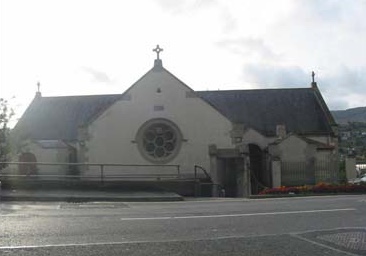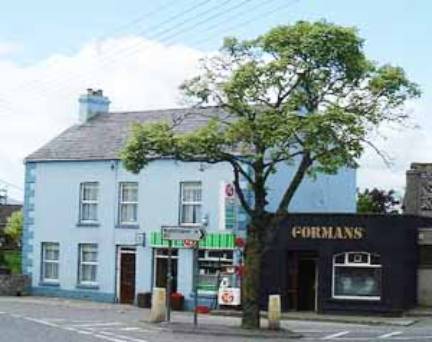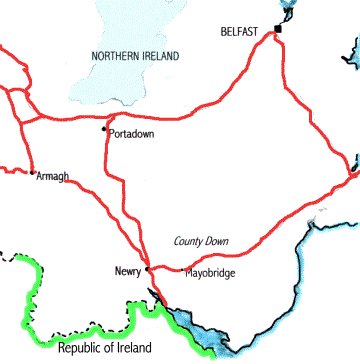
The fields in Croan townland, where the Gaffey family farmed.
This block will be replaced by LeftMenuGaffey.html when the page is served from a server.
- Lived:
- near Mayobridge in Clonallan Parish, near Newry, County Down Ulster (bet c1800 and c1850)[1],[2]
- Death:
- between 1847-1857[3]
- Marriage:
- Mary Torley (17 September, 1825, Newry Catholic church)
- Children:
- Patrick GAFFEY ( c1827-1901)
- William GAFFEY (1828 - bef 1841)
- Daniel GAFFEY (1835-1916)
- Mary Ann GAFFEY (1840-1863/64)
- William GAFFEY (1841-1913)
- James GAFFEY (1844–1917), married Margaret Berryman, 1862, Bundarra
- Bernard GAFFEY (1847-1910)
Although our family has a number of Irish ancestors, the Gaffeys are probably the only ones to have been hard hit by the disaster that was the Great Famine of the mid 19th century. The family's patriarch, Daniel, died sometime after the start of the famine in 1847, and before the mid -1850s, by which time the rest of his family had escaped from the poverty of their few rented acres in County Down to the lesser poverty of the English industrial midlands.
Daniel Gaffey himself is a mystery man. We have no actual record of his birth, baptism or death - but even more intriguing, records show that he was either a tenant farmer in County Down, or, a "hatter" (once described as a "journeyman hatter". A journeyman refers to someone who is hired by the day, not having his own business.). This is the description used by his eldest son Patrick, but not by Patrick's younger siblings, who described their father as a "farmer". The term "farmer" is a bit of a stretch, too - the family worked a meagre rented seven acres near Newry, in County Down, from the 1820s until Daniel's death.
The "hatter" occupation for his father was given by Daniel's eldest son Patrick on Patrick's own marriage certificates (Patrick was married twice in the 1850s in England) and given again in Australia by Patrick's son PJ Gaffey for the information on the death certificate of PJ's uncle Daniel in Australia.
Even his name, Gaffey, is not too common in the county he lived in. The stronghold of the Gaffey clan was traditionally an area north of the town of Athlone, in Westmeath, a county in the centre of Ireland. More than a few Gaffeys were active in the Rebellion of 1798, and when that was bloodily put down, they went on the run. According to a local report of the time:
Tuesday 1st May: We hear from Athlone on Saturday night a party of carabineers together with detachments of the yeomen, cavalry and infantry proceeded to the lands of Broomhill on an information of concealed arms. Some pikes, a few guns with a small quantity of powder, balls and swan drops etc, were discovered by the force of picketing. Three persons were lodged securely in Athlone and two persons named Gaffy, concerned in the above named concealments escaped in a boat across the Shannon, though a great number of shots were fired at them, the effect of which could not be known.'[4]
Did one of those Gaffeys escape and head north to Ulster, and settle for anonymity in the foothills of the Mountains of Mourne to raise a young Daniel Gaffey?
Unfortunately, records of the area are few and far between – even
information on births, deaths and marriages is limited. Under the
restrictions imposed on the Catholic population of Ireland, Catholic
churches in the province were not allowed to keep regis ters
much before 1830, and those of Clonallon Parish, near Newry in
County Down, are very sketchy, although records of Daniel's wedding
to Mary Torley in 1826 in the Catholic church in Newry (right)
have survived.
ters
much before 1830, and those of Clonallon Parish, near Newry in
County Down, are very sketchy, although records of Daniel's wedding
to Mary Torley in 1826 in the Catholic church in Newry (right)
have survived.
Surviving records of the time suggest that if the Gaffey children
did go to school, it would have been to the small National (Catholic
School) in Mayobridge, near the Catholic chapel. The school was a
"small slated cottage", established in November 1832. However, the
fee for each pupil was one shilling per quarter - but despite this,
it had an enrolment in 1836 of 103 boys and 48 girls, all of them
Catholics[5].
It's more than likely that the Gaffey children did not attend - or
if they did, the lessons they learned weren't long lasting, as more
than a few of them appear to have been illiterate, signing their
names with crosses later on in life in documents in New South Wales.

(right): Mayobridge, a small picturesque village 8 kilometres from Newry, in County Down, Northern Ireland.
Today (2000), old houses of the village are centered around Gorman’s pub and a shop but the village is expanding with many new houses being built on its outskirts
In 1834, in the Tithes Applotment books for the Parish, Daniel is listed as an occupier of land in the old townland of Crone (more usually spelt Croan) in Clonallan Parish[6]. The nearest village, Mayobridge, was about three kilometres to the south of Daniel’s rented land which totalled 7 acres, 2 roods, and 34 perches, over four allotments. The main crop in the area, as noted by the Tithe clerks, was oats, which sold at an average price of 13s 3p 3f per barrel; as well, there were two linen mills close by.
The Gaffey’s landlord was the Meade family, who owned considerable property in the province. They were absentee landlords, keeping mainly to their estate in England, with their interests looked after by an agent, Crane Brush. The welfare of their tenants was never uppermost in their minds – in the mid 1840s, they decided cattle and sheep were more profitable than tenants and less of a liability, and Brush refused to renew many leases, thus evicting many families and pushing them into emigration.[7]
 By
the time the Griffiths’ Valuation of the Croan townland was carried
out in 1845-48, Crane Brush’s plan had been largely successful. The
number of occupied houses had been reduced to four, instead of the
dozens listed there only 15 years earlier, in the Tithes’ survey.
The Gaffeys were not among those still living there during the
Valuation.
By
the time the Griffiths’ Valuation of the Croan townland was carried
out in 1845-48, Crane Brush’s plan had been largely successful. The
number of occupied houses had been reduced to four, instead of the
dozens listed there only 15 years earlier, in the Tithes’ survey.
The Gaffeys were not among those still living there during the
Valuation.
What is certain is that Daniel had died by the time the surviving members of his family, led by his eldest son Patrick, made the move to Staffordshire in England, then to Australia, where they settled in the New England district of New South Wales over the period 1857-62.
(right): Dan Gaffey’s allotments were in the townland of Croan, a tiny farming area, with two linen mills, just north of the village of Mayobridge.
_________________________________
[1] Tithes Applotment Book, Clonallan Parish, 1834, Vol2
[2] Parish Records for Clonallan Parish, 1828-1847
[3] Index to assisted immigrants arriving Sydney and Newcastle 1844-1859, Persons on bounty Ships (Board’s Immigrant List), 1857, and NSW Index to Immigration Deposit Journals, 1853-1900, Archives Office of NS where it's noted he was deceased.
[4] Belfast Newsletter, May 4, 1798
[5] Details on the school from the Ordnance Survey Memoirs of Ireland, Parishes of County Down 1, 1834-6, South Down, Vol. 3, p1 (eds: Angelique Day and Patrick McWilliams, for the Institute of Irish Studies, University of Belfast)
[6] Clonallon was both a civil and an ecclesiastical parish.
[7] Sean McCartan, an Ulster history researcher.